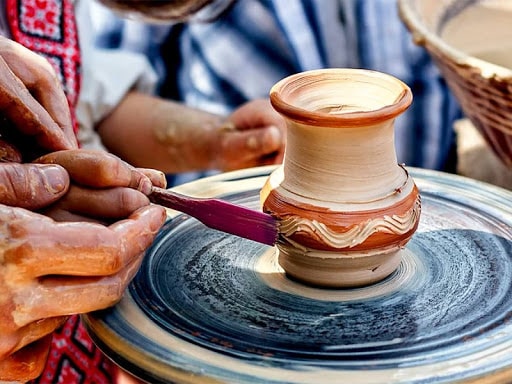Ceramics and its adventures
Did you know? Parts of your watches, microwaves, dishes or even your dental crowns are made from ceramics. Whether artistic or simply utilitarian objects, ceramics have been present everywhere around us since the end of prehistory.
Commonly referred to as the first “art of fire”. Ceramics appeared before glass art and metallurgy. Its etymology comes from the Greek “keramos” meaning “pottery”. It thus designates the potter’s art and all the work around the terra cotta. Ceramics is the material that has been the most used for the manufacture of objects.
Timeless, it has the particularity to reflect the different periods of history through the expression of peoples. Ways of life, morals, trends of societies are inscribed in ceramics. Moreover, the use of this material also highlights technical progress. And this, thanks to the use of the four natural elements that are water, earth, wind and fire.
Indeed, this balance makes it possible to obtain creations as diverse as they are unique. Used as a means of artistic expression or for purely utilitarian creations, ceramics is to the imagination what space is to the universe, infinite.
A diversity of ceramics more important than one might think.
But what is really ceramics? In common parlance, this word refers to an earthenware object that has been fired more or less slowly at a higher or lower temperature. There are several kinds of ceramics, each with their unique properties and particularities; stoneware, earthenware, porcelain and pottery or commonly known as terracotta.
The pottery
Pottery is a ceramic made from common clay. Mostly of reddish color but can go in gray tones. This material is said to be porous by nature. In other words it is waterproof only if it is waterproofed with a glaze (enamel). This is called varnishing. To work on it, several techniques can be used such as turning (material turning on a disc), mounting in colombine or modeling.
The firing temperature of this ceramic is between 800 and 900°C. It is this material that is most often used in children’s potter’s apprentice play sets. This is a simple to work with and non-toxic material.
Earthenware
Then, the earthenware is a soft and clayey paste ceramic, always covered with glaze to waterproof it. It is often used when the artist aims to make paintings on it. As for clay, the techniques for working it are diverse; moulding, turning, mounting in colombine… In the majority of the cases, it will be fired a first time at 900°C without painting. Then, a second time with the decoration painted on the enamel at low temperature, around 700°C.

Porcelain
There is also porcelain, which is a ceramic with a vitrified paste in the mass, and therefore impermeable. It is recognized by its immaculate whiteness and its transparency in certain creations. Of Chinese origin, porcelain is a fragile material but difficult to scratch according to its composition. Its firing temperature is however high. Indeed, the kilns must be heated between 1200 and 1400°C.
Stoneware
Finally, there is in the family of ceramics, stoneware. The latter has a high concentration of silica. It has a watertight base without enamel, but its firing at high temperature (about 1250°C) allows a perfect vitrification. This material allows fewer colors than earthenware but is easier to work to achieve effects on the object.
The revival of a forgotten trend
After having lost its popularity, we notice today a more and more important search for a return to manual creations, home-made, craftsmanship. The trend is the search for durable hand-made objects. As a result, fields such as ceramics are coming back into fashion and the talent of craftsmen is more and more in the spotlight.
Think about recycling!
Concerning the recycling of ceramics, it is good to know that this material is considered inert. That is to say that it does not pollute water, does not pollute the soil, does not decompose and does not pose a problem for the health of living beings. Although it is harmless, it is important to treat it because huge volumes of ceramics are destroyed every day. They must therefore be recycled.
You can therefore take your ceramic waste to your municipal waste disposal center. After that, the process is simple. The ceramic will be transported to a recycling center where it will be reduced to powder. This powder will then be able to find a second life in the backfill of building sites, in road construction or in the manufacture of concrete.

